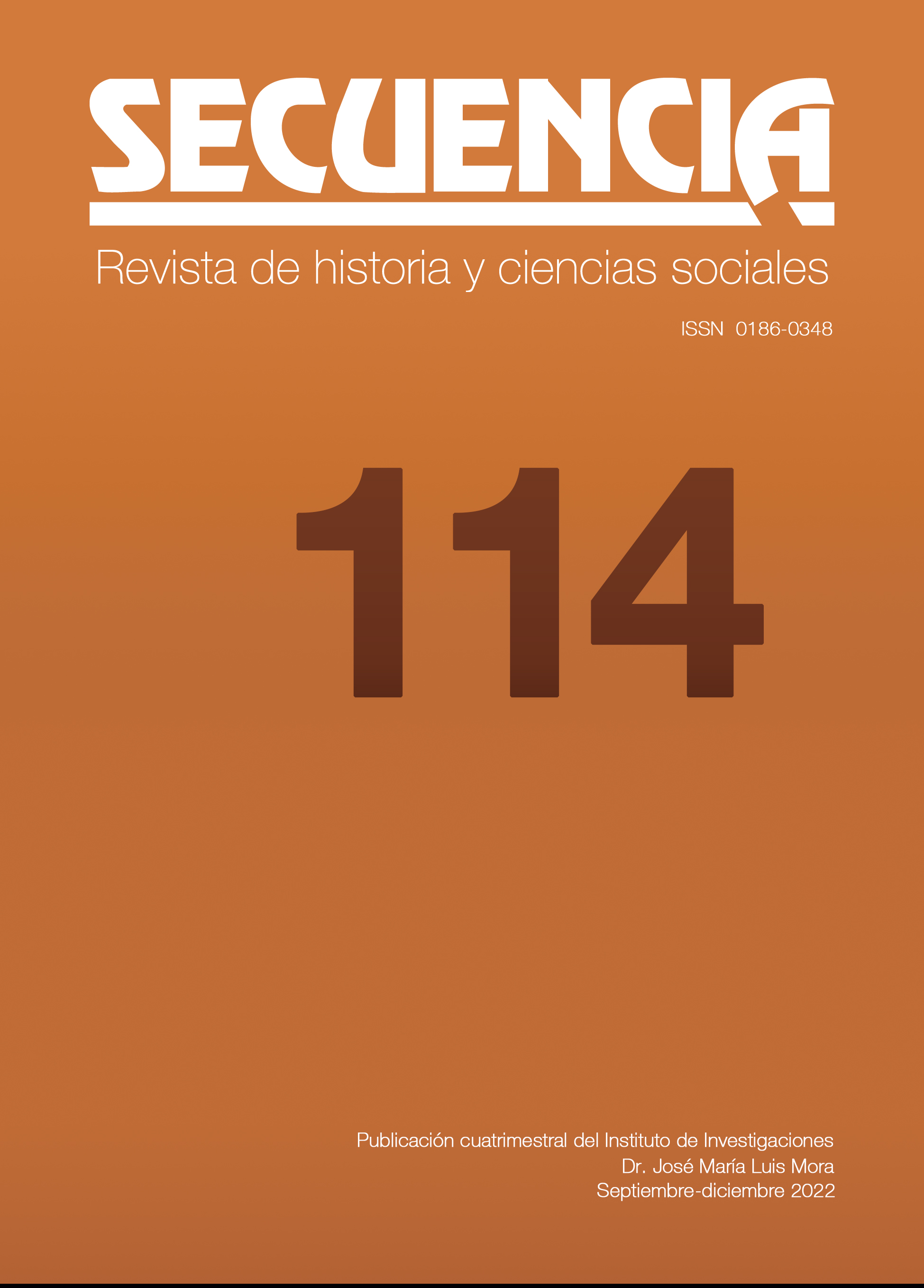Abstract
This text studies the political activism of the community of American deserters living in revolutionary Mexico during the first world war. The article focuses on Charles Francis Phillips, a rebellious New Yorker who fled to Mexico in May 1918. There, he became actively involved in the Mexican radical left and met Soviet government agents, engaging in efforts to establish The Communist International in Mexico, Cuba, Guatemala, Spain, and the United States. Indeed, exiles like Phillips played a crucial role in the postwar radical left, particularly in the development of communism in the Americas and beyond. Their defection and exile radicalized them and intensified their political commitment, and, thanks to their mobility, they established transnational networks they would use to establish the communist movement on an international scale.
References
REFERENCIAS BIBLIOGRÁFICAS
Andrade, Juan (1983). Recuerdos personales. Barcelona: Serbal.
Beals, Carleton (1938). Glass Houses: Ten Years of Freelancing. Philadelphia: Lippincott.
Bizcarrondo, Marta y Elorza, Antonio (1999). Queridos Camaradas: La Internacional Comunista y España, 1919-1939. Barcelona, Planeta.
La Botz, Dan (2006). American “Slackers” in the Mexican Revolution: International Proletarian Politics in the Midst of a National Revolution. The Americas 62, no. 4, 563-90. DOI: https://doi.org/10.1353/tam.2006.0081
Carr, Barry (2013). Radicals, Revolutionaries and Exiles: Mexico City in the 1920s. Berkeley Journal of Latin American Studies. Recuperado de https://clas.berkeley.edu/research/mexico-radicals-revolutionaries-and-exiles-mexico-city-1920s
Chambers, John Whiteclay (1987). To Raise an Army: The Draft Comes to Modem America. New York: Free Press.
Conti, Piero (1972). Le divergenze fra gli uffici europei del Comintern (1919–1920). Movimento operaio e socialista 2 (abril–junio): 133–92.
Draper, Theodore (2003). The roots of American Communism. New Brunswick: Transaction Press.
Gómez, Manuel (1964). From Mexico to Moscow. Soviet survey, 53.
Goldman, Emma (1970). Living My Life, vol. 2. Dover: Nueva York.
Keith, Jeanette (2001). Politics of Southern Draft Resistance during World War. The Journal of American History 87, no. 4, 1335-1361.
Jeifets, Víctor (2007). Frank Simen: meksikanskii delegat v sovietskoi Rossii. Americana 9: 145-173.
Katz, Friedrich (1984). The Secret War in Mexico: Europe, the United States, and the Mexican Revolution. Chicago: Chicago University Press.
Lomnitz, Claudio (2014). The return of comrade Flores Magón. New York: Zone Books.
McBeth, Brian (2007). Foreign Support for Venezuelan Political Exiles During the Regime of Juan Vicente Gómez: The Case of Mexico, 1923-1933. The Historian 69, n. 2, 275-304.
Melgar Bao, Ricardo (2009). Cominternismo intelectual: Representaciones, redes y prácticas culturales en América Centra, 1921-1933. Revista Complutense de la Historia de América 35, 135-159.
Oikión, Verónica (2009). De la Revolución mexicana a la Revolución mundial. Actores políticos michoacanos y la Internacional Comunista en México. Signos Históricos 21, 60-103
Pons, Silvio (2014). The Global Revolution: An International History of Communism, Oxford: University Press.
Roy, M. N (1964). Memoirs. Bombay: Allied Publishers.
Shipman, Charles. 1993. It Had to be a Revolution: Memoirs of an American Radical. Ithaca: Cornell University Press.
Smith, Stephen A (2014). The Oxford Handbook of the History of Communism. Oxford: Oxford University Press.
Spenser, Daniela (2007). Emissaries of the Communist International in Mexico. American Communist History 6, no. 2: 151-70. DOI: https://doi.org/10.1080/14743890701645175
Taibo II, Paco Ignacio (1986). Bolchevikis: Historia narrativa de los orígenes del comunismo en México (1919-1925). Tabasco: Planeta.
Taibo II, Paco Ignacio and Vizcaíno, Rogelio (1984). Memoria roja: luchas sindicales en los años 20. Ciudad de México: Júcar.
Taracena Arriola, Arturo (1989). El primer Partido Comunista de Guatemala (1922-1923): diez años de una historia olvidada. Anuario de Estudios Centroamericanos 15, no. 1, 49-63.
Valadés, José C (1985). Memorias de un joven rebelde. Sinaloa: Universidad de Sinaloa.
Wolikow, Serge (2010). L’Internationale communiste (1919-1943): le Komintern ou le rêve déchu du parti mondial de la révolution. Paris: Midi, 2010.
Zoffmann Rodríguez, Arturo (2021). Embajadas y barricadas: Mijaíl Borodin, su equipo y los orígenes del comunismo en México y España, 1919-1920. Estudios de Historia Moderna y Contemporánea de México 62 (en imprenta).
REFERENCIAS DE ARCHIVO
CEMOS Centro de Estudios del Movimiento Obrero y Socialista, Ciudad de México, México
FPI Fundación Pablo Iglesias, Alcalá de Henares, España
HGARC Howard Gotlieb Archiva Research Center, Universidad de Boston, Massachusetts, Estados Unidos
HIA Hoover Institute Archive, Palo Alto, California, Estados Unidos
RLA Rose Library Archive, Emory University, Atlanta, Estados Unidos
REFERENCIAS HEMEROGRÁFICAS
Santa Fe New Mexican
The Oklahoma City Times
The Washington Times
New York Tribune
Tusla Daily World
The Liberator
El Soviet
Aquellos autores/as que tengan publicaciones con esta revista, aceptan los términos siguientes:
- Los autores/as conservarán sus derechos de autor y garantizarán a la revista el derecho de primera publicación de su obra, el cuál estará simultáneamente sujeto a la Licencia de reconocimiento de Creative Commons Atribución-NoComercial 4.0 Internacional que permite a terceros compartir la obra siempre que se indique su autor y su primera publicación esta revista.
- Los autores/as podrán adoptar otros acuerdos de licencia no exclusiva de distribución de la versión de la obra publicada (p. ej.: depositarla en un archivo telemático institucional o publicarla en un volumen monográfico) siempre que se indique la publicación inicial en esta revista.
- Se permite y recomienda a los autores/as difundir su obra a través de Internet (p. ej.: en archivos telemáticos institucionales o en su página web) antes y durante el proceso de envío, lo cual puede producir intercambios interesantes y aumentar las citas de la obra publicada. (Véase El efecto del acceso abierto).




